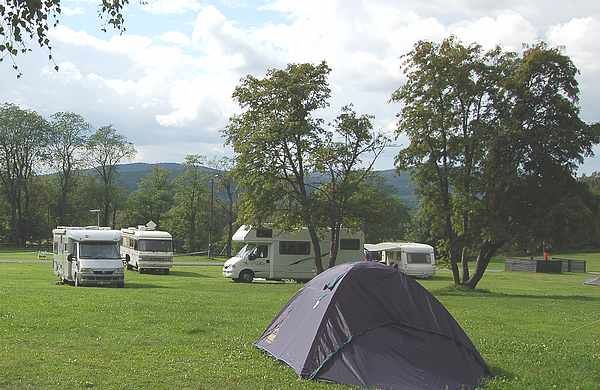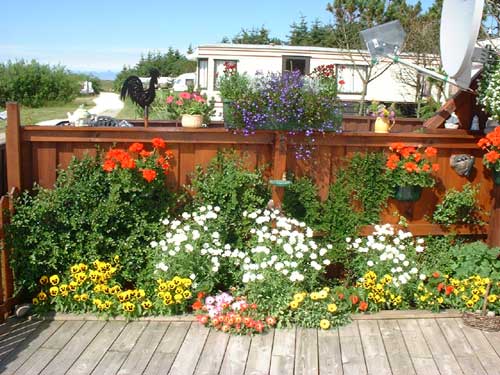This is the story of campsites in Norway, part 5. This is also the last part of my series on the story of campsites after WW2. I ask, what are the most recent developments and trends?
The sites
The table from Statistics Norway named “Campingplassar” shows interesting trends in the period from 1998 to 2011. In this period the number of campsites decreased by 19 %, from 953 to 768. The number of overnight stays increased by 11 % during the same period, from 7.3 million to about 8 million.

Bogstad Camping (Oslosurf). Motorhomes, caravans and a tent in complete harmony.
This means that on average, a campsite increased its occupancy throughout the year from 7,621 to 10,521 guest nights. Motorhomes have experienced a strong growth, unlike tents, caravans and cabins. On the other hand they made up only 12 % of all overnight camping stays in 2011 compared to 8 % in 1998.
I wrote in the first chapter that there were in 1959 reportedly 400 campsites. Statistics Norway had in 1988 a register of 1400 campsites and in 2011 the number was 768. From this one might have concluded that there are fewer campsites now than before. On the other hand the national census bureau only builds upon reports from campsites above a certain size.
If we take a look at other lists, there were in 2012 a number of 255 campsites according to the industry’s own association. The national tourist authority lists 532 sites and this camping guide claims 1200. So what to believe?
This map shows the location of campsites in Norway today. There are seemingly lots of them.
It is perhaps more interesting to take notice of another figure from Statistics Norway: Campsites made up almost 30 % of all guest nights in the country in 2011. This means they still play an important role in the tourism industry.

Brusand Camping overview
The customers
Camping and caravaning has all through the years been most popular among Norwegians on a small or medium sized income, and with less education. This type of vacation is comparatively cheap, and it is predictable. This had led to a row of prejudices, or what some would say rather accurate descriptions, about a group unwilling to expose themselves to foreign and unknown food, culture, habits and languages. From what I know, there are huge variations among the campers. (Here is another article.)

Brusand Camping “nail tent” garden
The content
Making campsites permanent “villages” it is no wonder that the voted best campsite in 2011, Moysand, boasts of “a capacity of 300 caravans, all with 16 ampere power, cable-TV and broadband”. “Moysand also offers cabins. They have an area of 63 sqm and are built with a very high standard 1.5 storeys high. They all have toilets, shower, and sauna, and sleep 8 persons”.
In addition campsites I have paid virtual visits to in preparing this article, boast of many activities on the grounds, keeping their visitors busy and active – if they want to.

Moysand Camping
Conclusion
You are reading the story of campsites in Norway (part 5).
My personal experience is that there are few tents on the campsites, and the ones we see are small. The sites are filled with caravans and motorhomes. Many pitches are rented on long terms (69 % of NCC members) and equipped with extra constructions like a terrace and an adjoining little cabin. Writing this article I have browsed a number of websites and tried to find recent pictures of campsites in Norway. They all leave me with the same impression.
I read in a newspaper that there may be a retro-trend coming in terms of camping, but that seems to be wishful thinking. I have very little belief that there will be a revival of the importance campsites had in the Norwegian population in the first thirty years after the war.
On the other hand, campsites continue to hold an important position in the Norwegian tourism industry for both natives and foreigners. 30 % of all lodgings in the country are on campsites. Foreigners now account for 25 % of all visits. The number of nights spent on Norwegian campsites has had an interesting development: 4.3 million (1970), 5.3 million (1981), 4.7 million (1991), 7.1 million (2001) to 8,1 million (2011).
Campsites in Norway have been facing fierce competition from a number of reasons over the last fifty years, but they have continuously been adapting. Their features have changed considerably over the years and they have even succeeded in expanding their activity and popularity. This means that the era of campsites is far from over.

Gol Camping – “Spikertelt” (Campingdagboka.com)
Further reading
Few web resources are available in non-Norwegian languages. The following reading-list mentions if they are.
Utne camping presents its own history, so does Vangen. Bandak campsite is for sale, here is the ad (removed link).
“Caravan-historie” (article removed) is an article in text and figures on the history of caravans supplied by Norsk Caravan Club. They also have another interesting article (removed too). The Norwegian built popup camper “Lillebror” is described here.
Newspaper articles: VG and Aftenposten describe the best campsites in 2011 and 2012 and Adressa deals with “camping for beginners” defining it as roaming the country in a recreational vehicle. Aftenposten wrote in 2010 about a “stream of new campers”. In 2012 news came that 46 years of camp history at the Molde Jazzfestival was over: The reason was little interest, consequently few tents. This is the full story about this jazzcamp (sorry, link is dead). Dagbladet published an article on social mobility based on the commentator’s own camping experience.
Here is an article (dead link) from Norwegian comedian Per Inge Torkelsen describing his camping holidays as a teenager in the 1960s.
.
Publications from Statistics Norway are linked in the text and repeated here (often English summaries):
- “Ferieundersøkelsen” was released some years dealing with vacations: 1968, 1970, 1974
- Friluftsliv, idrett og mosjon (1975)
- 70-åras feriereiser (1982)
- Ny offentlig campingstatistikk (1989 by ØR)
- Norsk Hotellnæring 1950-1990 (1992)
- Camping in Norway 1984-1994
- Short facts (2009)
- Travel statistics 1991-1999, table 46
- Statistical yearbook 2012, table 403 with figures from 1998-2011
- Table no. 20.52. Number of nights on campsites 1976-2009
Campingguiden.no offers information in Norwegian, German and English about campsites. Camping.no issues a booklet available in pdf in the same languages. The tourist authority Visit Norway offers basic information about camping in English. CampingNorge.no boasts being the most extensive portal to camping in Norway (Scandinavian languages only). Many campsites were connected to the three motoring organisations in Norway with NAF as the most important. This is NAF’s online guide.
Finally
You have read the story of campsites in Norway (part 5). This is the last of five sections about campsites in Norway during the last 50 years.
(1) The beginning, the classic period of tents in the 1950s and 60s.
(2) My camping experience from the 1960s and 70s.
(3) Growing competition from charter flights and good incomes in the 1970s and 80s. Caravans are starting to dominate.
(4) Decade of rapid transformation, the 1990s. Permanent sites for caravans, more cabins and caravans with high standards, tents out, enter the motorhomes.
(5) The last decade, recent developments and further reading.
Les artikkelserien om campingplasser på den norskpråklige delen av dette nettstedet.


